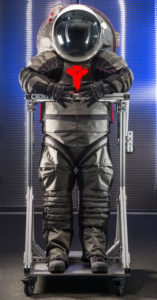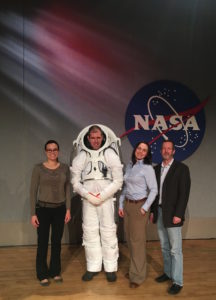
The MS-1 Suit is testing at the Haughton-Mars Project (HMP) in November 2019 – Photo Credit Dave Hodge @davehodgephoto |Unexplored Media
It takes a village to make a spacesuit. From the engineers, artists, and design geniuses who conceive of its overall shape, to the tailors who sew the soft portions and the steel-workers who make the bearings, when it comes to a spacesuit, it’s all-in. Then, there’s the testing. Always, the testing. When you’re basically building a spacehipt for a human being to wear as they go about their business, it’s hard to know when you’ve done enough testing. So it is with immense pride and gratitude towards all of those who contributed, that I create a page dedicated to expressly to the MS-1: The Mars Simulation Suit.

The International Mars Rover Champions from Missouri S&T suited up in the MS-1 in November 2017. See the entire video here..
Designed for simulated astronauts by simulated astronauts, and by the brilliant staff and students at the Rhode Island School of Design with assistance from NASA Johnson Space Center, the MS-1 is a high-fidelity analog suit for use in planetary exploration simulations. The MS-1 embodies elements of NASA’s new Z2 planetary suit. It is the correct weight (50 lbs/22.7kg). It has (elements of) a hard upper torso. It has bearings in the arms for greater mobility. In the MS-1, you can raise your hands all the way up over your head and give yourself a hug.
The MS-1 is fairly adjustable – with cinches at the waist, knees and elbows – and, in a change space suits in the ISS, is a design with gravity-based fieldwork in mind (picking up rocks, hitting things with hammers, and such). Unlike the Z2, the MS-1 does not maintain its own internal atmosphere. Since Mars analogs take place on Earth, there’s no need for it to be pressurized. Rather than be pressurized, the Z2 is made of a thick material that doesn’t bend easily. This has a few advantages. First, to the wearer, it feels a b

it like you’re in a suit filled with air, because in part, you are. Pockets of replaceable filling material make the limbs stiff. Air is constantly being blown through the wide-necked sleeves and legs. This helps keep the wearer cool. When you fall in the suit while trudging over the rough terrain, the limbs cushion the fall, and help prevent harm both to the wearer and the equipment inside.
Watch a video about the cooling system design made by Adam Savage on April 1, 2020 – it’s no joke!
The Z2 has a HUT – or hard upper torso – meant for docking into an airlock. This is one of those things that science fiction  never gets right. You know that scene in The Martian where everyone is standing around in the main part of the dome discussing whether or not to flee from the oncoming storm? The crew that had just been outside performing and EVA, or extravehicular activity, is still wearing their suits. For many practical reasons, this is a no-no. First of all, everything on the surface of Mars, suits and all, ends up rapidly coated in dust; and not just any dust. As I wrote in 2014, Mars is awesome at breaking expensive equipment. One of the many reasons for this is that the surface dust is ultra-fine and magnetized. It floats through the think air in powdery waves, aided by just enough trace humidity to stick to even non-magnetic surfaces. Walking into the habitat with your suit on would mean dragging a bunch of magnetized dust particles the thickness of a human hair into right into the dome. As the equipment hasn’t yet been invented yet, I can’t say what that would do to the equipment inside. I can say that I wouldn’t like to spend my time battling dust contamination indoors as well as outdoors. Speaking of contamination, when you bring Mars inside with you, all of Mars comes inside. Whatever was floating around out there now gets into your food, your water, your bedding, your med kit – you name it. Everything that isn’t sealed is contaminated. The same goes for Mars when you put that same suit back on and head outside again. Mars, meet Earth. Earth, Mars.
never gets right. You know that scene in The Martian where everyone is standing around in the main part of the dome discussing whether or not to flee from the oncoming storm? The crew that had just been outside performing and EVA, or extravehicular activity, is still wearing their suits. For many practical reasons, this is a no-no. First of all, everything on the surface of Mars, suits and all, ends up rapidly coated in dust; and not just any dust. As I wrote in 2014, Mars is awesome at breaking expensive equipment. One of the many reasons for this is that the surface dust is ultra-fine and magnetized. It floats through the think air in powdery waves, aided by just enough trace humidity to stick to even non-magnetic surfaces. Walking into the habitat with your suit on would mean dragging a bunch of magnetized dust particles the thickness of a human hair into right into the dome. As the equipment hasn’t yet been invented yet, I can’t say what that would do to the equipment inside. I can say that I wouldn’t like to spend my time battling dust contamination indoors as well as outdoors. Speaking of contamination, when you bring Mars inside with you, all of Mars comes inside. Whatever was floating around out there now gets into your food, your water, your bedding, your med kit – you name it. Everything that isn’t sealed is contaminated. The same goes for Mars when you put that same suit back on and head outside again. Mars, meet Earth. Earth, Mars.
Frankly, we’re hoping to hold off on the formal introductions until after we’ve thoroughly explored Mars for signs of life past and present. Ergo, the suits stay in the airlock. The way that works is that the flat back of the suit dock into the side of the airlock wall. The back of the suit and the airlock connect, evacuate any stray bits, and then let the astronaut out. Imagine escaping from a scuba suit by flipping the tanks to one side and leaning backwards out of the suit, leaving the goggles, fins and everything else in the water. That’s about the right image1. As you can see from the photos, the upper torso of the MS-1 isn’t completely solid. There’s a reason for this: It was designed so that almost anyone who might end up on a mission with an MS-1 could wear it. Like a metal rod propping up a window, the MS-1 has a plate on the front of it that holds the two arm bearings apart. If the plate, called the Q-spacer, is small, the arms are subsequently close together, and the suit is more suited for a smaller person. Swap a much longer spacer into the front. Now, a even maximum-height2 mammal like our chief engineer can work his way into the suit and still be able to move his arms around in a semi-normal fashion.
Funny story – when the suit was being build at RISD, the first Q-spacer we tried on was too small. Captain Stewart moved his arms and -pop! It was like watching the Incredible Hulk try on a spacesuit. This is why testing is important. Speaking of which, since the MS-1 should be able to fit almost anyone in the corps, we planned to send it up to HI-SEAS for the next mission. The suit was done in time. All the bits were boxed up and ready to go. Then we stopped…a took stock. Spacesuit are complicated devices. In space, people depend on them for their lives. In simulation, they are a major component of safety. The suit was built, sure, but it’s hadn’t been thoroughly field tested. In our minds, that meant that it wasn’t ready – not for eight months at HI-SEAS V, anyway. Before sending it on a long trip up a big mountain, we first needed to shake it down. Step one to a thorough suit shake-down was a trip to Johnson Space Center. The MS-1 debuted there on February 9th, 2016. Not only was JSC a fitting place to bring a simulated space suit, it’s one of the few places on

From left to right, Jocelyn Dunn, Andrzej Stewart in the MS-1, Sheyna Gifford (speaker), Professor Michael Lye from RISD, where the MS-1 suit was built.
Earth where there are real spacesuits and people who know how to use them. In a way, it was like bringing our home-built kit car to Ferrari in Italy and saying, “So – what do you all think?” In another way, if you’re serious about putting your car in a race – and care more about safety and performance than pride – that’s where you take your rig: to the place where people know what safety and performance look like. To the place where the people win races every day. In March, we’ll take the suit to MIT, where a lot of very smart people spend a lot of time thinking about space design. Then we’ll take it for a serious of walks: longer and longer strolls over rougher and rougher terrain, until we’re satisfied that we’re sending a safe and useful tool to simulated Mars: one that will pay for its weight and complication by giving sim astronauts the best (and most realistic) experience possible.
Link to the Suit-Testing at the Haughton-Mars Project (HMP)
If you or a colleague run a short-duration space simulation appropriate for analog suit testing, please give us a call! We’ll be here all year.

MS-1 Testing at the Haughton-Mars Project (HMP) – Photo credit Dave Hodge @davehodgephoto |Unexplored Media
News Coverage
- USA today (Video)
- Associated Press (video)
- Daily Orange
- Mercury News
- RISD
- MORE RISD
- Composites Manufacturing
- The Projo (aka Providence Journal)
- WCIA
- ABC
- PBN
- Tech Times





